Classic Airframes 1/48 Meteor T.7
After three years of operating the Meteor, it was becoming obvious that there was a need for a trainer, so that new jet pilots could have the opportunity of learning more about their mounts before being turned loose on their own. This had been made very clear to Gloster after the crash of the F. Mk.4 demonstrator, G-AIDC, with a Belgian first-timer at the controls, the company decided that never again would they allow a Meteor to be flown without the supervision of their own test pilots.
The sale of 100 Mk. 4s to Argentina in 1947 brought 12 Argentine pilots to England for flight training. To instruct the students in the art of taxying, the canopy was removed from an F. Mk.4, so that the Gloster instructor could sit astride the fuselage behind the cockpit yelling instructions and signaling by hand until the students were proficient enough for a solo.
As a result of this, Gloster decided to privately develop a trainer based on the Mk.4 airframe, whose main change was a 30-inch extension to the forward fuselage to allow a second fully-equipped cockpit, and a heavily-framed canopy over both cockpits which opened to the right on the ground. Neither the prototype nor any operational Meteor trainers would be equipped with ejection seats.
The Gloster G.43 T.7 Trainer made its first flight on March 19, 1948. The performance was only slightly less than that of the single-seater. Official interest in the private-venture trainer was immediate, with the Air Ministry issuing Specification T.1/47 to cover an RAF version. The prototype, registered G-AKPK, was painted bright scarlet with cream letters, and toured several countries before eventually being sold to the Royal Netherlands Air Force in November 1948.
The two cockpits of the T.7 eliminated the need for nose ballast, replacing that with an extra 200-gallon fuel tank, while there was also provision for a 180-gallon ventral tank and two 200-gallon underwing tanks. The first production T.7, VW410, flew on October 26, 1948, while the last, XF279, was delivered July 27, 1954; of the 500 T.7s produced, many were rebuilt from F.4 airframes for the RAF. While the prototype had been powered by the Derwent 5, production aircraft were powered by the Derwent 8. While both the F.4 and F.8 had aileron trim tabs that extended beyond the trailing edge, this was replaced by a trim tab which extended along the length of the aileron, without extending beyond the trailing edge.
In service, the T.7 equipped several training squadrons; additionally, every operational Meteor squadron included at least one T.7 and generally two, which were provided for continuation training and such things as IFR proficiency reviews, target towing and liaison. The type was so popular with pilots that its use was not limited to squadrons which operated Meteors, with several Vampire and Venom-equipped units carrying a T.7 on the books, and Meteor trainers formed the station flight of virtually every RAF base throughout the 1950s and early 1960s. With the return of colorful squadron markings in 1951, T.7s operated by first-line squadrons often had their yellow trainer stripes removed, and were repainted in the same manner as the operational aircraft; T.7s of 74 Squadron RAF and 607 Squadron RAuxAF even received camouflage schemes. The Fleet Air Arm adopted the Meteor T.7 as its standard jet trainer; the type also was used for IFR proficiency and target towing, and used the airplane to equip station flights until the last - WS103 - was retired from service from Yeovilton in January 1967.
Following final delivery to the RAF, the T.7 remained in production to fill orders from Australia, Belgium, France, Denmark, the Netherlands, Egypt, Brazil, Israel and Syria. Two Israeli T.7s were re-equipped with the camera nose and became the only T.7s to see combat, flying in the photo-reconnaissance role in Operation Kadesh, Israel's participation in the 1956 Suez War. The 45 T.7s operated by the Royal Netherlands Air Force made the Dutch the second-largest user of the type. In 1955, Flight Refuelling Ltd. modified the first of three T.7s that would be operated by Svenska Flygjaenst as target tugs for the Swedish air Force. The last flight of a Brazilian T.7 came on October 7, 1971, with the last Israeli T.7 retiring from service at about the same time, two having served with the Vautour-equipped squadrons of the IDF/AF for proficiency training since the introduction of that type into Israeli service.
T.7 WA634 was utilized by Martin-Baker in the development of the Martin-Baker Mk.4 ejection seat, which was the first seat to have zero-zero capabilities. The first demonstration of this seat was performed by Squadron Leader John Fifield at Chalgrove Aerodrome on September 3, 1955. At a speed of 120 mph, Fifield fired the seat and was ejected to an altitude of 70 feet, his parachute deploying at 30 feet for a successful landing.
Because the T.7 could carry an observer, the aircraft was used in numerous engineering development programs until the mid-1970s, including development of the remote-control system for drones and the firing trials of the Firestreak AAM.
As with all the other Classic Airframes Meteors, fit is problematic. I managed to squeeze in lead fishweights around the cockpit and fill the area immediately behind. The wing was again attached in pieces. Lower center first, then left and right uppers, then left and right lower outers, then intakes. Even with fit gotten as close as possible that way, the model was still a putty monster. I also decided to do the model with the canopy closed to preserve the the aircraft's lines, even though this means one cannot see much of the cockpit detail through the thick canopy.
I decided to do WS103, the last T/7 operated by the Fleet Air Arm in the late 1960s, which was flown in a scheme of black with orange day-glo. Anyone who has tried to use day-glo paint knows how hard it is. After trying and failing a first time, I mixed in some regular orange and decided to do weathered day-glo. Once those areas were masked, the rest was painted with Tamiya semi-gloss black. Kit decals were used for the markings.
The end result is a really distinctive-looking model. If you have the kit, Xtradecals do a sheet with T.7s on it. The Meteor T.7 served with many different air forces and the markings are not that difficult to piece together.
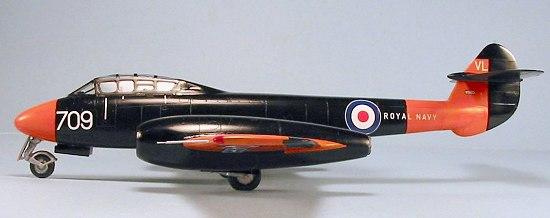

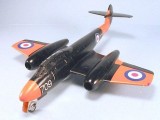
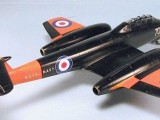
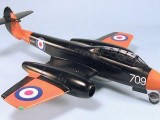
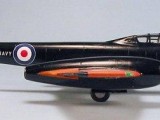
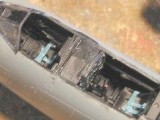
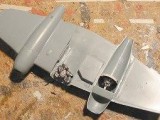
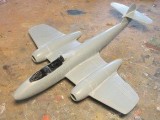
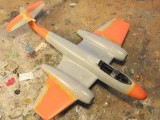
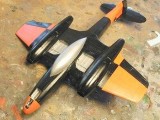
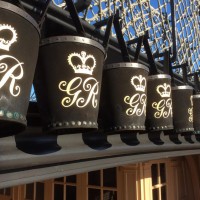
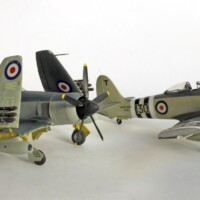
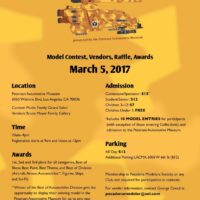
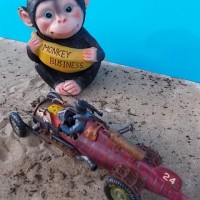
Very nice and interesting painting scheme. Looks good!
Very nicely Done,
what a cool scheme
Nice clean build, ya' gotta love that black/orange paint, very sharp.
Tom, very classy looking Meteor. Nice job!
Nice looking model - inspiring me to attack a Revell Fairey Gannet with Red Gloss / Silver scheme.
Nicely done there Tom.
A sweet job.
Cool colour scheme, and thanks for the history.
Tom,
Very nice. I like the scheme.